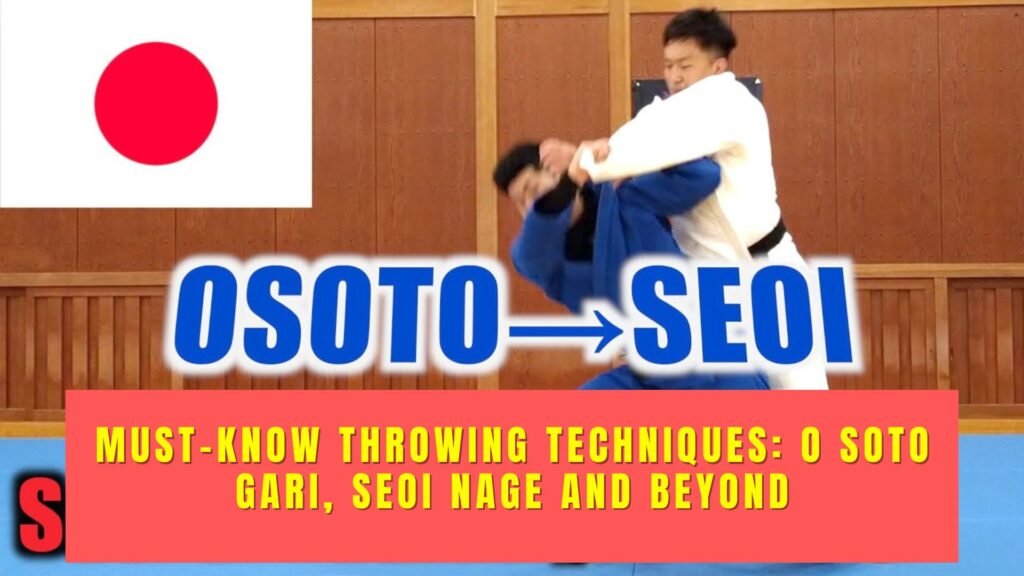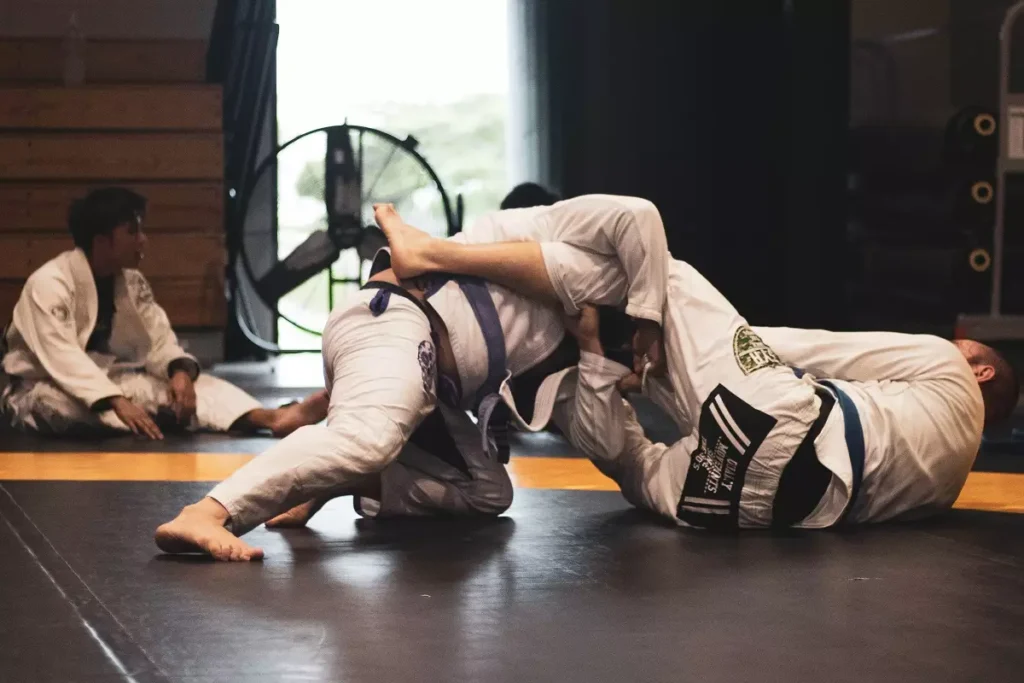Contents
Introduction
Judo and jiu-jitsu are Japanese martial arts renowned for their advanced throwing and grappling techniques. Mastery of certain foundational throwing skills like O Soto Gari (major outer reap) and Seoi Nage (shoulder throw) variations is essential for any aspiring judoka or grappler.

This comprehensive guide will teach you:
- Detailed mechanics and step-by-step instructions for executing O Soto Gari, Morote Seoi Nage, Ippon Seoi Nage and more
- Solo drills to ingrain proper technique through repetition
- Combinations and set ups to apply the throws against resistance
- Breakfall methods to safely receive throws during randori or competition
- Physical conditioning to develop throwing power
With diligent practice of these fundamental judo throwing techniques and concepts, you’ll have the skills to off-balance opponents and execute devastating match-ending throws. Let’s get started!
H1: Mastering O Soto Gari
O Soto Gari (大外刈) translates to “major outer reap” referring to the foot reap used to upend training partners. It’s considered one of the original 40 throws of Jigoro Kano’s Kodokan Judo syllabus. It remains a staple technique due to its simplicity and efficacy across all levels.
Executing O Soto Gari Step-by-Step
To perform O Soto Gari:
- Gripping: Grab uniform at chest level, one hand high and one hand low. Dominant leg back.
- Reaping: Lift reaping leg in circular fashion.
- Contact: Make calf-to-calf contact while reaping backwards.
- Off-Balance: Keep chest upright and pull uke diagonally across body.
- Throw: Whip reaping leg backward forcefully to throw uke to the ground.
Here is a video demonstrating correct O Soto Gari technique:
It takes lots of practice to ingrain the specific hand, foot, and hip coordination required for clean O Soto Gari execution. Let’s go over some key tips and common mistakes.

Important Hand Positioning
Proper hand position helps control uke for throw setup…
Table: Hand Positioning Tips
| High Hand | Wrap fabric across uke’s shoulder blade |
|---|---|
| Low Hand | Grip lapel near hip to limit downward mobility |
Footwork and Reaping
The reaping leg motion…
Common O Soto Gari Mistakes
- Reaping too early before off-balance
- Reaping too shallow, missing calf contact
- Turning reaping leg inward
Fixing these issues ensures more consistent throwing success.
O Soto Gari Solo Drills
Integrating structured O Soto Gari drills into training routines accelerates development:
Footwork Drill
- Shift weight side-to-side while lifting leg
Benefits: Grooves lower body coordination
Reaping the Air Drill
- Dry reps of reaping motion
Benefits: Sharpens leg whip
Crash Pad Drills
- Throw into padded surfaces solo
Benefits: Conditions throw follow through
Perform sets of 20-30 reps daily to ingrain neural patterns.
Using O Soto Gari in Randori and Shiai
O Soto Gari’s simplicity makes it an ideal go-to technique when struggling to attack in randori:
- Disrupts opponent’s rhythm
- Creates reactions to counter
- Low risk of sacrificing position when missed
It also sees frequent use in shiai or tournament fighting for its speed and capability to score ippon when executed properly against a committed attack.
Set up O Soto Gari against common techniques like uchi mata or tai otoshi attempts using blocks and evasions.
H2: In-Depth Guide to Seoi Nage
Seoi Nage translates to “shoulder throw” referring to lifting opponents up and over the back. It’s considered one of the highest percentage throws in judo given the torso leverage. Let’s break down the major Seoi Nage variations.
Variations of Seoi Nage
There are four main Seoi Nage variants Along with key distinctions:
| Throw | Key Distinctions |
|---|---|
| Morote Seoi Nage | Two-handed throw |
| Ippon Seoi Nage | One-handed throw |
| Seoi Otoshi | Dropping to one knee |
| Seoi Goshi | Hip assist |
The most applicable across all levels is the Morote Seoi Nage or two-handed throw.
Now let’s examine its key phases.
Step-by-Step Mechanics
Morota Seoi Nage utilizes three distinct phases:
Initial Grip
Establish collar or sleeve control on one side to limit mobility while…
Tsukuri Fitting In
Insert arm under armpit and load uke onto back while staying chest to chest.
Kake Execution
Explode upward with legs driving into the ground and throw uke overhead.
Here’s a video breaking it down further:
Mistakes like improper gripping or posture make throws much harder.
Training Solo Drills
Seoi Nage-specific strengthening helps avoid injuries:
- Shoulder presses
- Good mornings
- Shrimp squats
Their facility improving back and leg drive prevents excessive shoulder strain.
Perform them for 3-5 sets of 5 repetitions focusing on speed and power development rather than maximal strength.
Combinations and Setups
Seoi Nage chains well with techniques like O Soto Gari after forward momentum is halted.
- Uke shifts backwards reacting to O Soto → open for forward Seoi
- Uke blocks O Soto → arm position primes Seoi entry
Drill sequences with training partners to open new throwing opportunities.
Competition Application
Seoi Nage’s frontal position makes it less susceptible to landing in guard or turtle during tournament application.
Look to hit it against:
- Freestyle takedown attempts
- Reactionary shots from striking exchanges
- Times opponents posture too tall during grip fighting
With proper lapel control, Seoi Nage can more easily score ippon via throw’s force.
H3: Advanced Throwing Concepts
Now that we’ve covered foundational throw execution, let’s level up on key concepts that’ll make techniques more effective regardless of chosen variation.
Kuzushi (Off-Balancing)
Kuzushi refers to distorting an opponent’s balance before throw attempts. Throws executed without proper off-balancing often fail even with perfect individual mechanics.
Table: Types of Kuzushi
| Direction | Method |
|---|---|
| Forward | Overcommitting attacks |
| Backward | Blocks and pulls |
| Lateral | Cut angles and foot sweeps |
| Vertical | Posture manipulation |
Force reactions with pushes and pulls from different angles to limit stability.
Tsukuri (Entry Phase)
Tsukuri is positioning uke vulnerable for impending throws via grip adjustments or evasive footwork
- Footsweeps to disrupt base
- Ducking under punches into prime Seoi position
- Blocking Osoto to spin uke off-balance
Guide training partners into throws through resistive practice.
Renraku Waza (Combinations)
Renraku Waza combines multiple throws in sequence catching opponents off guard:
- O Soto Gari → Seoi Nage
- Push-pull momentum for frontal lift
- Ko Uchi Gari → Seoi Nage
- React to blocked reap with forward throw
Drill transitions between favorite techniques to make attacks more unpredictable.
Kaeshi Waza (Counters)
Kaeshi Waza counters opponent’s throws with timed defense into immediate attacking:
- Attempted Osoto → pivot for rear throw
- Defend hip throw → forward Seoi
Practice correcting poor throw timing by training partners to land counters.
Breakfalls and Rolls for Safety
Learning proper breakfall techniques ensures ability to receive throws safely during practice and competition. Let’s overview the main methods for safely landing prone or supine.
Why Learn Breakfalls?
Thousands of judo throws are executed daily in practice globally. Being slammed repeatedly onto a hard surface inevitably causes injuries without proper landing knowledge.
Types of Breakfalls
Backward Ukemi: Slap arm to diffuse impact energy
Forward Rolling: Distribute force in rounded shape
Side Falls: Redirect using limbs to avoid ribs, hips, and head
Here’s a breakfall compilation:
Drills for Mastering Rolls and Falls
All breakfalls require frequent repetition to ingrain reactions:
Solo Rolls on Mats – Regain comfort being inverted
Falling from Knees and Standing – Increase height progressively
Take Falls for Throws – randori where focus is receiving safely
Avoid trying to catch throws by straightening arms or landing rigidly.
Fitness and Strength Training
While throwing skills grant technical proficiency, physical attributes determine applicability against fully resisting opponents. Let’s outline fitness essentials for throwing efficacy and injury resilience.
Developing Gripping Strength
A judoka is only as strong as their grip strength allows them to be against intense resistance. Specific training must address the crushing power and endurance critical for controlling clashes.
Grip Training Tools
- Hand Grippers
- Towel Pull-ups
- Wrist Curls
Use thick bars and high resistance bands to fortify tendon health.
Building Explosive Power
Throws require tremendous speed and coordination to hit before opponents can react. We must apply athletic movement patterns for more effective technique execution.
Plyometrics
- Throwing Motions with Resistance Bands
- Alternating Lateral Hops
- Vertical Leaps
Weight Training
- Hang Cleans
- Jump Squats
- Feet-Elevated Push-ups
Medicine balls and kettlebells allow fluid transitions between explosive patterns.
Sport-Specific Conditioning
- High Intensity Randori rounds
- Repeated Uchi Komi Drills
- Footwork Agility Drills
Functional fitness centered on grappling demands develops proper motor pathways.
Preventing and Recovering from Injury
Hard throws and overuse take a toll on even the most durable judokas’ bodies overtime. Implementing preventative protocols facilitates lengthier health.
Warm-ups and Cooldowns – Gradually ramp intensity up and down
Stretches – Full body mobility and tissue quality restoration
Rest and Recovery – Listen and allow injuries to fully heal
With diligent prehabilitation, one can participate in throwing arts for decades to come.
Conclusion
Fundamental judo throwing skills like O Soto Gari, Seoi Nage, and variants provide a foundation for a well-rounded grappling skillset. Layering in advanced throwing concepts around off-balancing, combinations, and counters will lead to more dynamic attack systems against resistance.
By supplementing training with falls, grip strength conditioning, and injury prevention protocols, standup techniques can be drilled productively for years.
Hopefully this guide has provided a strong base. Please check out more throwing resources below:
- Advanced Judo Throwing Techniques
- Judo Info Site
- Read Next on Mastering the Art of Gripping and Setups in Judo
FAQs
Here are 50 top FAQs for the judo throwing techniques blog post:
How do I practice ukemi (breakfalls)?
Practice ukemi by repeatedly falling onto mats from your knees and standing, increasing the height over time to get comfortable landing prone or supine.
Which throw is easiest to learn first?
The O Soto Gari (major outer reap) is typically easiest to learn as a foundational judo throwing technique due to its simple mechanics.
What muscles does Seoi Nage (shoulder throw) mainly utilize?
Seoi Nage uses the hips and back to lift opponents overhead, making spinal erectors, glutes, hamstrings, and core essential.
Does proper grip fighting skill translate to better throwing?
Yes, good grip fighting lets you better control opponents to set up throws while stripping grips prevents being thrown.
How much grip strength is ideal for advanced judo throwing?
An advanced judoka should aim for over 60-70 kgs of crushing grip strength in each hand for applicable throwing power.
What throws best set up combination opportunities?
Foot sweeps like Ko Uchi Gari open opportunities for additional forward or rear throws against a disrupted opponent.
Where should hands be positioned for basic right-sided O Soto Gari grip?
Right hand high on shoulder blade, left hand lapel near front of hip to limit mobility away from throw side.
Is Seoi Nage legal in BJJ competition?
Some BJJ rulesets do not allow dropping straight to the knees so the standing posture Seoi Nage variant may be permitted.
How do I modify Seoi Nage grip for no gi grappling?
Without the gi for grip, you can lock onto rear waistbands or neck instead to hoist opponents up effectively no gi.
What throw counters Osoto Gari attempts?
Counters like Sasae Tsurikomi Ashi that lift and sweep the support leg shut down forward momentum from Osoto Gari attempts.
What exercise improves explosive power for throws?
Olympic lift variations like hang cleans and jump squats train explosive hip extension power applicable for hard throw setups.
Should I practice throws to crash pads alone when starting out?
Only practice solo throwing drills onto crash pads once properly conditioned to avoid injury until breakfall proficiency is developed.
How long should I grip train daily to improve judo?
Aim for 5-10 minutes daily of high intensity specific grip training via thick bar holds, towels, or hand grippers.
Will lifting weights make my throws slower?
No, full body strength training including Olympic lifts and plyometrics develops power to make throws faster when technique is refined.
Where should I look to set up combination attacks?
Look to combine throws like Osoto Gari off reactionary momentum when initial attacks are blocked by opponents.
Why develop strong grips for throwing?
Gripping strength allows better control of opponents for throw setups when they strongly defend techniques.
How can I condition shoulders for repeated Seoi Nage practice?
Strengthen shoulders via wall walks, handstands, and external rotation exercises using bands or cables.
What common mistake causes failed O Soto Gari throw execution?
Reaping too early before off-balancing or turning toes inward shreds power; delay reap until the final moment.
Can advanced counters still work for beginners in throwing?
Yes, beginners can have success using basic counters like block and pivot throw sets against telegraphed technique attempts.
What throws are least likely to sacrifice position after attempts?
Attempts using frontal lifting momentum like Seoi Nage variants make it simple to continue grappling exchanges after.
How do I grip fight for lapel control needed for Ippon Seoi throws?
Strip away initial sleeve control of opponents while hunting for lapel grips on either side to ready Ippon Seoi entries.
What throwing style tournaments favor Seoi techniques?
Seoi Nage variants see significant success under freestyle judo, BJJ gi, no gi grappling rule sets awarding throws executed with power.
Where is O Soto Gari grip typically initiated?
The typical starting grip for right handed O Soto Gari features the right hand controlling shoulder area fabric while left hand secures lower lapel.
What throw can I practice softly alone safely when starting out?
Foot sweeps like De Ashi Barai use minimal impact so new students can mindfully practice principles solo before throwing humans.
How do I develop skill hitting combinations throws?
Drill flowing between your favorite primary throws and counters against resisting partners to build sequences unpredictability.
What prevents me from executing Seoi Nage effectively?
Suboptimal grip choice and posture plus minimal hip involvement when throwing stops ideal Seoi Nage execution.
Why should I strengthen hips if throws use arms and legs?
Total body connectivity generates power as throwing techniques ultimately channel forces upward through tensed glutes and hip drive.
Can lifting directly replace throwing practice for power?
No, lifting develops foundational muscle power for transfer while technique drilling ingrains specific skilled movement patterns unique to judo.
How often should I practice solo O Soto Gari drills?
Aim for performing 20-30 standalone O Soto Gari solo reps daily to sharpen reaping timing and positioning.
What muscles fail first on grip strength without training?
Forearm flexors and fingers give out before back strength when gripping untrained; reverse with specific training.
Will breakfall practice eliminate throwing injuries?
No, it prevents the worst damage but cannot fully remove risk as high amplitude throws may still cause traumatic falls. But skills minimizing injuries acquired over time.
How do I safely build up breakfall durability?
Gradually build durability by increasing throwing height monthly only after completely adapting to less intense levels without pain.
Why should new students focus on grip fighting?
Grip fighting proficiency allows novice students more opportunities setting up attacks against unwilling partners while limiting throw exposure.
What mistake causes O Soto Gari to reap too shallow?
Letting the reaping leg drift inward instead of straight backward near perpendicular causes more shallow calf contact misses during O Soto Gari attempts.
Does repetition of a throw truly perfect technique?
No, repetitions ingrain bad habits without mindful corrections; pursue quality, not just quantity of practice by self-assessment after each drill set.
Can I reduce excessive shoulder and neck strain when executing Seoi throws?
Yes, persistent strengthening of upper back muscles and thoracic mobility minus ego lifting reduces shoulder impingement risk long-term.
How do I safely channel hip power upward while throwing?
Maintain upright posture and brace core instead of bending solely at waist to avoid excessive spinal loading when transmitting force.
What are the highest percentage throwing targets for competition?
Frontal lifting throws like Seoi Nage and inner leg reaps when executed with force offer highest scoring rates.
How should I modify training after throwing injuries?
Avoid reinjury by addressing movement limitations, grip strength deficits, and rebuilding technical compliance to reduce positional flaws that caused problems initially.
What causes failure to complete O Soto Gari despite getting past reap?
Insufficient back diagonal off-balancing and lack of hip hinge follow through results in loss of control post-reaping motion before total throw execution.

[…] Read Next on Must-Know Throwing Techniques of Judo: O Soto Gari, Seoi Nage and Beyond […]